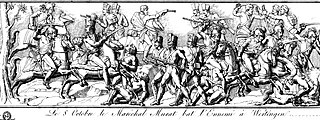 W
WEvents from the year 1805 in Austria
 W
WThe Battle of Austerlitz, also known as the Battle of the Three Emperors, was one of the most important and decisive engagements of the Napoleonic Wars. In what is widely regarded as the greatest victory achieved by Napoleon, the Grande Armée of France defeated a larger Russian and Austrian army led by Emperor Alexander I and Holy Roman Emperor Francis II. The battle occurred near the town of Austerlitz in the Austrian Empire. Austerlitz brought the War of the Third Coalition to a rapid end, with the Treaty of Pressburg signed by the Austrians later in the month. The battle is often cited as a tactical masterpiece, in the same league as other historic engagements like Cannae or Gaugamela.
 W
WThe Battle of Caldiero took place on 30 October 1805, pitting the French Armée d'Italie under Marshal André Masséna against an Austrian army under the command of Archduke Charles, Duke of Teschen. The French engaged only some of their forces, around 33,000 men, but Archduke Charles engaged the bulk of his army, 49,000 men, leaving out Paul Davidovich's corps to defend the lower Adige and Franz Seraph of Orsini-Rosenberg's corps to cover the Austrian right against any flanking maneuvers. The fighting took place at Caldiero, 15 kilometres east of Verona, during the War of the Third Coalition, part of the Napoleonic Wars.
 W
WIn the Battle of Castelfranco Veneto, two divisions of the French Army of Italy confronted an Austrian brigade led by Prince Louis Victor de Rohan-Guéméné. The Austrians had made a remarkable march from deep in the Alps to the plains of northern Italy. But, caught between the divisions of Jean Reynier and Laurent Gouvion Saint-Cyr, Rohan surrendered his command after failing to fight his way out. The event occurred during the War of the Third Coalition, part of the Napoleonic Wars. Castelfranco Veneto is located 40 kilometres (25 mi) northwest of Venice.
 W
WThe Capitulation of Dornbirn saw the French VII Corps under Marshal Pierre Augereau face an Austrian force led by Franz Jellacic. Isolated near Lake Constance (Bodensee) by superior numbers of French troops, Jellacic surrendered his command. The event occurred during the War of the Third Coalition, part of the Napoleonic Wars. Dornbirn is located in the Austrian province of Vorarlberg, about 12 kilometres (7 mi) south of Bregenz at the eastern end of Lake Constance.
 W
WThe Battle of Dürenstein, on 11 November 1805, was an engagement in the Napoleonic Wars during the War of the Third Coalition. Dürenstein, Austria, is located in the Wachau valley, on the river Danube, 73 kilometers (45 mi) upstream from Vienna, Austria. The river makes a crescent-shaped curve between Dürnstein and nearby Krems an der Donau, and the battle was fought in the flood plain between the river and the mountains.
 W
WThe Battle of Elchingen, fought on 14 October 1805, saw French forces under Michel Ney rout an Austrian corps led by Johann Sigismund Riesch. This defeat led to a large part of the Austrian army being invested in the fortress of Ulm by the army of Emperor Napoleon Bonaparte of France while other formations fled to the east. Soon afterward, the Austrians trapped in Ulm surrendered and the French mopped up most of the remaining Austrians forces, bringing the Ulm Campaign to a close.
 W
WThe Battle of Haslach-Jungingen, also known as the Battle of Albeck, fought on 11 October 1805 at Ulm-Jungingen north of Ulm at the Danube between French and Austrian forces, was part of the War of the Third Coalition, which was a part of the greater Napoleonic Wars. The outcome of this battle was a French victory.
 W
WThe Battle of Mariazell or Battle of Grossraming saw the advance guard of the French III Corps attack a retreating Austrian force led by Maximilian, Count of Merveldt. The advance guard, led by Étienne Heudelet de Bierre overwhelmed their demoralized enemies, capturing about half of them. Marshal Louis Davout commanded the III Corps. The action occurred during the War of the Third Coalition, which is part of the Napoleonic Wars. Mariazell is located in the Austrian province of Styria, about 50 kilometres (31 mi) south of St. Pölten.
 W
WThe fourth Peace of Pressburg was signed in Pressburg on 27 December 1805 between French Emperor Napoleon Bonaparte and Holy Roman Emperor Francis II, as a consequence of the French victories over the Austrians at Ulm and Austerlitz. A truce was agreed on 4 December, and negotiations for the treaty began. The treaty was signed in Pressburg, Kingdom of Hungary, by Johann I Josef, Prince of Liechtenstein, and the Hungarian Count Ignác Gyulay for the Austrian Empire and Charles Maurice de Talleyrand for France.
 W
WThe Battle of Schöngrabern, also known as the Battle of Hollabrunn, was an engagement in the Napoleonic Wars during the War of the Third Coalition, fought on 16 November 1805 near Hollabrunn in Lower Austria, four weeks after the Battle of Ulm and two weeks before the Battle of Austerlitz.
 W
WThe Ulm campaign was a series of French and Bavarian military maneuvers and battles to outflank and capture an Austrian army in 1805 during the War of the Third Coalition. It took place in the vicinity of and inside the Swabian city of Ulm. The French Grande Armée, led by Napoleon Bonaparte, comprised 210,000 troops organized into seven corps, and hoped to knock out the Austrian army in the Danube before Russian reinforcements could arrive. Through rapid marching, Napoleon conducted a large wheeling maneuver that captured an Austrian army of 23,000 under General Mack on 20 October at Ulm, bringing the total number of Austrian prisoners in the campaign to 60,000. The campaign is generally regarded as a strategic masterpiece and was influential in the development of the Schlieffen Plan in the late 19th century.
 W
WThe Battle of Ulm on 16–19 October 1805 was a series of skirmishes, at the end of the Ulm Campaign, which allowed Napoleon I to trap an entire Austrian army under the command of Karl Freiherr Mack von Leiberich with minimal losses and to force its surrender near Ulm in the Electorate of Bavaria.
 W
WThe Battle of Verona was fought on 18 October 1805 between the French Army of Italy under the command of André Masséna and an Austrian army led by Archduke Charles, Duke of Teschen. By the end of the day, Massena seized a bridgehead on the east bank of the Adige River, driving back the defending troops under Josef Philipp Vukassovich. The action took place near the city of Verona in northern Italy during the War of the Third Coalition, part of the Napoleonic Wars.
 W
WIn the Battle of Wertingen Imperial French forces led by Marshals Joachim Murat and Jean Lannes attacked a small Austrian corps commanded by Feldmarschall-Leutnant Franz Xaver von Auffenberg. This action, the first battle of the Ulm Campaign, resulted in a clear French victory. Wertingen lies 28 kilometres (17 mi) northwest of Augsburg. The combat was fought during the War of the Third Coalition, part of the Napoleonic Wars.